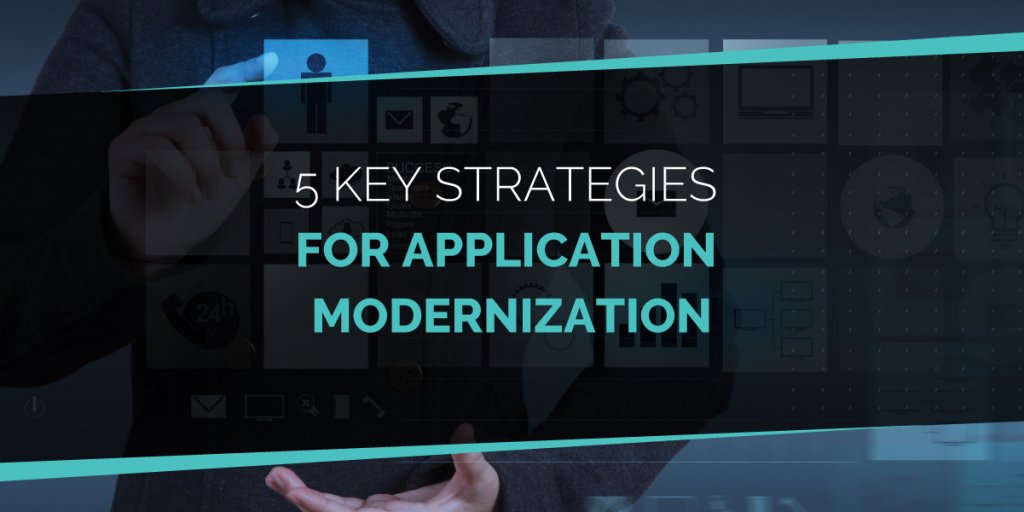
Large enterprise organizations have multiple business-critical applications. Their IT team and budget are typically tied up maintaining these legacy systems, and as a result, the resources remaining to innovate or modernize are often very limited.
Given this reality, you need a framework to determine how to modernize your application portfolio.
5 Strategies for Application Modernization
As it turns out, once you decide to modernize your applications, you have five key migration options - the 5 R’s of application modernization:
- Rehost
- Refactor
- Rearchitect
- Rebuild
- Replace
We will discuss each of these options, and the reasons why you should choose one over another.

Struggling to Choose the Right Journey to the Cloud?
[gem_button position="center" size="medium" corner="3" icon_pack="elegant" text="Get an Application Migration Assessment" link="url:%2Fcontact-us%2F||target:%20_blank|" background_color="#40c8c4" hover_background_color="#0f525b"]
1. Rehost
Also known as the ‘lift and shift’ model, this approach involves moving your application’s underlying resources from an on-premise data center to the cloud as-is. In this option, the application codebase remains the same, the infrastructure is migrated to cloud infrastructure-as-a-service (IaaS), including cloud-based storage, compute, and network resources.
While potentially the easiest to implement, this approach still leaves the application as is — for good or bad. Attempting to take existing applications — especially monolithic legacy applications — and move them onto a cloud infrastructure will not take advantage of essential cloud-native features, including: PaaS, multi-cloud, microservices, agile methodology, containers, CI/CD, and DevOps practices.
Potential downsides with this approach compared to cloud-native options include:
⦁ higher cloud service costs
⦁ potential security issues
⦁ slower time to market
⦁ scaling is usually all-or-nothing rather than based on what actually needs to scale
⦁ higher downtime
⦁ less automation in the CI/CD pipeline
⦁ less modular design impacting development team performance
⦁ less resilient / fault tolerate operations
⦁ continued technical debt
⦁ a lost opportunity to improve customer experience and operational efficiencies
As mentioned, this is often a first step in the cloud migration journey. Applications that are less strategic may stay rehosted, and each should be considered on a case by case basis to weight the pros and cons.
2. Refactor
In this second option, the application codebase largely remains the same while it is migrated to cloud infrastructure-as-a-service (IaaS), including cloud-based storage, compute, and network resources. Developers can reuse investments in languages, frameworks, and containers, thus leveraging the organization’s strategic code. Refactoring shares most of the drawbacks of the Rehost strategy above. It can create a perception of “being modern” and properly leveraging te cloud, but this is not the case.
3. Re-architect
In this next option, the legacy monolithic application is re-architected according to the microservices model, containerizing them and rolling out modern DevOps practices.
This involves decomposing or dividing your monolithic application into a collection of services that can be built, deployed and managed independently of one other. It involves materially altering or decomposing the application into services rather than a complete rebuild.
This divide and conquer approach to architecture puts more control in your hands and provides benefits including business agility, faster time to market, reduced costs, and an opportunity to reinvent the customer experience. Technologies leveraged include cloud-provided PaaS (where desired), microservices, serverless, containerization, and modern DevOps practices.
Learn More About Rearchitecting Applications:
4. Rebuild
To achieve the most substantial benefits of the cloud, and for any application that can provide a strategic or competitive advantage for your organization, we recommend rebuilding as a cloud-native application. This option involves the most fundamental change and delivers the most value among the 5 R’s.
It is similar to a rearchitecture; however, as in homes, rather than remodelling you are flatting it down and starting fresh. And similar to a home, starting fresh can sometimes be more cost effective and usually yields in a much better result compared to a remodelling project.
With a rebuild, the application is rewritten as a cloud-native application, helping to accelerate innovation, release value faster, and reduce overall operational costs. One interesting consideration is that the effort required to initially build the legacy application could be vastly more than that to rebuild it today, given advances in technology, languages, frameworks and other efficiencies. Lower level programming once required is now usually abstracted.
Examples include code once required for application lifecycle, custom network protocols, and security. Literally, thousands of lines of code can often be replaced with dozens or a few hundred, again and again throughout the application.
5. Replace
If a legacy app has some functionality that is still useful, you can sometimes replace it with a more nimble cloud-based solution. A simple example would be replacing an on-premise version of Microsoft Exchange Server with the cloud-based Office 365. The consumption of these services changes from a purchased license to a pay-as-you-go subscription.
Benefits of such software-as-a-service (SaaS) solutions include always running the latest version without the need for updates, potential cost savings, potentially better security, and shifting the support burden outside of the organization.
Learn How You Can Begin Your Legacy Application Modernization
Modernizing an application for cloud-native is the most far-reaching (and potentially costly) approach. It ranges from limited refactoring to rearchitecting, to an entire app rebuild. In the best case, it involves adopting a modern DevOps approach, future-proofing the application, and delivering all the benefits of cloud-native.
As such, we strongly recommend this for the few applications that can help differentiate the business and improve customer experience. To truly achieve the benefits of the cloud, look to rearchitect or rebuild those applications that are important in your digital transformation strategy.
A common approach is to first rehost the application to derive some basic cloud benefits, and then fully rearchitect or rebuild it to maximize these benefits over the long term.
As you begin, you will benefit from a partner with expertise in such modernization programs. You will need deep cloud-native skills plus the design thinking and product expertise to ensure the new applications are loved by the people that will use them. Making an optimal transition from a legacy monolith to the cloud isn’t easy, but a capable partner can help you successfully plan and execute the modernization.
Learn More:
- Legacy Application Modernization: What Does It Mean?
- 6 Benefits of Cloud-Native Applications for Business
- How to Modernize Applications






























